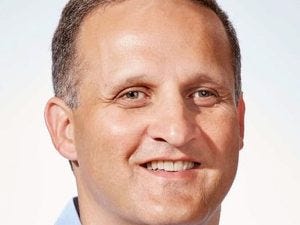Exclusive: As AWS Turns 15, Doug Yeum Predicts Even More InnovationExclusive: As AWS Turns 15, Doug Yeum Predicts Even More Innovation
The head of channel talks milestones, what’s coming, telecom agents and working with new CEO Adam Selipsky.

Amazon Web Services just celebrated a milestone birthday. The cloud vendor turned 15 on March 14. In the intervening years, AWS grew from the not-so-publicized Elastic Compute Cloud and S3 storage developer into the world’s largest public cloud provider — a fact that can still surprise even longtime insiders.
“Who would have thought the cloud industry and AWS would become the size that it is?”
That’s the musing of Doug Yeum, head of worldwide channels and alliances at AWS, a title he has held since July 2019. Prior to that, Yeum served as chief of staff to Andy Jassy, who is leaving AWS to become CEO of Amazon. Yeum, then, has watched, and been part of, significant change since joining AWS in 2014. Now, as AWS heads into its 16th year, efforts on behalf of indirect partners show no signs of slowing. As one example, on March 31, AWS officially released the Mainframe Migration Competency, first announced at the 2020 re:Invent conference. Yeum called the launch “important and unique.”

AWS’ Doug Yeum
“We’re the first in the industry to do that because more customers are asking partners to migrate mainframe applications to AWS,” he said. On the whole, he added, the competency represents “a huge opportunity for our partners.”
Look for AWS to unveil an expanded version of its machine learning competency soon, too, in addition to other areas of specialty. AWS sees potential for a range of partner competency programs, “whether technology-focused or industry-focused,” Yeum said. Customers are seeking such expertise when they choose their AWS partners, he noted. In response, AWS will introduce more competencies this year.
“We’re making sure we’re making the right investments into our partners and making sure we have the right differentiation in place,” Yeum said.
With that in mind, Yeum says AWS will keep pushing the boundaries.
“AWS is always focusing on innovating at a faster rate than any other company out there,” he said. “The impact AWS is having not only on our customers … but on all the great partners, both SIs and ISVs … gets me very excited. I think over the next 10-15 years of our business, you’re going to see more of that.”
Key Accomplishments, Lessons Learned for AWS Channel
As Yeum heads toward his second anniversary as AWS channel chief, he offered some reflections on accomplishments. The overarching one comes down to listening to partners and customers. That’s an ethos started by Jassy and carried on by Yeum and his team. As a result, services including contact-center-as-a-service platform Amazon Connect have morphed into big practices and revenue for some channel partners.
“The existing solutions were expensive and hard to manage,” Yeum said. “When we came out with Connect, it was much more flexible and customizable. … A number of partners were really eager to build a business around it.”
That success came of AWS’ willingness to listen to what organizations were requesting, Yeum said. “The majority of services we’ve developed over the years have been because customers told us they needed it.”
The same goes for initiatives for partners themselves — most recently in the form of …
“One of the things I did when I joined the partner organization was I wanted to bring the same mental model we had in product development,” Yeum said. “Partners are our customers and I treat them as customers. I’ve asked my team to spend a lot of time just listening, asking the right questions.”
ISV Partner Path, announced at last year’s re:Invent, marks a major outcome of that. Recall that ISV Partner Path removes tier requirements (consultants and system integrators still operate by tier). Participants get access to AWS marketing resources, training discounts and the new AWS ISV Accelerate Program. That initiative gives ISVs co-sell support and benefits such as reduced AWS Marketplace listing fees. As of January, any AWS partner with software that runs on or is integrated with AWS was eligible for ISV Partner Path.
“We’re moving away from badging a partner as select or advanced using tier requirements and instead we’ll start badging individual solutions from our partners,” Yeum said in December.
Dismantling that traditional tier setup for ISVs was nothing short of revolutionary, Yeum told Channel Futures.
“We broke the existing model, which is very hard to do when you have tens of thousands of partners already in the system,” he said. “It’s not an easy thing to pull off and we were able to do that successfully.”
Notably, the action came after AWS leaders digested ISV feedback.
“Partners said, ‘Tiers are not that important for us,’” Yeum said. “‘We’re more concerned about working closely with your team … and building solutions on AWS.’”
Of course, it’s not all sunshine and roses — sometimes channel conflict occurs. The chances of that increased as AWS ramped up its co-selling avenues through ISV Accelerate. That program serves ISVs who choose AWS as their preferred platform but want to operate a wholesale practice. While partners report AWS’ co-selling “is getting better and better every year,” Yeum said, overlap can happen. Two (or more) partners might pursue the same customer.
“There could be a lot of tension if you don’t manage in the right way,” Yeum said.
He cited two well-known companies where channel conflict arose. Thanks to his team, Yeum said, the executives of those firms “will tell you the relationship they have with AWS is the best it’s ever been.”
“We have to do the right thing for our partners,” he added. “ … Managing those challenging situations is, I would say, something I’m very proud of.”
What AWS Partners Can Expect Throughout 2021
Yeum also is passionate about the growth he has helped drive for AWS. He has no intention of easing off the pedal.
“What’s really exciting is the traction we’re starting to see in markets outside of North America,” he said.
AWS is answering customer demand in Europe, Asia Pacific, the Middle East, Africa and Japan, he said. Organizations in these regions “are now moving really fast and looking for strong partners to help with migration and modernization on AWS. … So we’re investing quite a bit to grow our important partners.”
But AWS is eyeing more than the large guys. It now serves the SMB space as well. The recent partnership with distributor Ingram Micro underscores that focus.
“A lot of SMBs are also using the power of cloud,” Yeum said.
As AWS pursues that sector, it will continue to align with …
… “key distribution partners,” Yeum said.
Those initiatives parallel the AWS channel’s ongoing efforts to push the envelope. For instance, Yeum wants to mirror the changes ISV Partner Path enables “with other types of partners.”
He could not yet discuss specifics when he talked with Channel Futures.
“Hopefully we’ll be able to make announcements [soon] about what we’re doing there,” he said.
The takeaway, he noted, is AWS is “ensuring our partners are the most differentiated partners.”
What About the Traditional Telecom Agent Channel?
Telecom agents are, by now, no strangers to the cloud world. Indeed, much of the “cloud” movement started with voice over IP telephony. But agent involvement in cloud technologies tends still to be more connectivity- and apps-related. Cloud infrastructure and software development remain more in the ISV/reseller/SI arena. Even so, there’s opportunity for worlds to collide, especially as agents themselves keep moving toward that cloud-first target.
Yeum, for his part, is open to working with partners AWS has not previously encountered. That’s because the company has no “cookie-cutter approach” to the indirect channel, he said.
“For me, it’s about listening to what partners are trying to accomplish,” he said. “We want to play an important role in helping them transform. … I feel like we have the muscle to actually do that with any partner.”
So, heads up, telecom agents — masters and subs alike.
“If there are partners that have built their businesses in a different era [and] around a different business model but want to continue to be successful and relevant, [we have] open arms,” Yeum said. “Come and talk to us. … I would be very open and very willing to engage the type of partner that you’re talking about.”
On Working with New AWS CEO Adam Selipsky

AWS’ Adam Selipsky
July will mark Yeum’s second full year at the helm of the AWS channel. By that time, he will have been working with new AWS CEO Adam Selipsky for about three months. (On March 23, AWS named Selipsky as Jassy’s replacement.) Yeum said he looks forward to collaborating with the “longtime Amazonian” who returns to the company after five years as CEO of Tableau. Selipsky worked for Amazon from 2005-2016.
Selipsky, Yeum said, holds a lot of similarity to Jassy.
“They both represent and demonstrate our leadership principles to the fullest,” Yeum said.
He indicated that choosing a former insider for the AWS CEO role was a savvy move.
“It’s great to have someone like Adam who understands the culture we have here,” Yeum said. “We’re unusually customer-focused, unusually longterm-oriented, we are all builders. … I believe Adam embodies our culture exceptionally well and think he’s going to become a great CEO for our business.”
Read more about:
AgentsAbout the Author
You May Also Like


